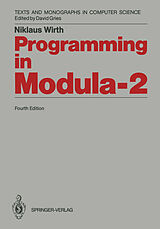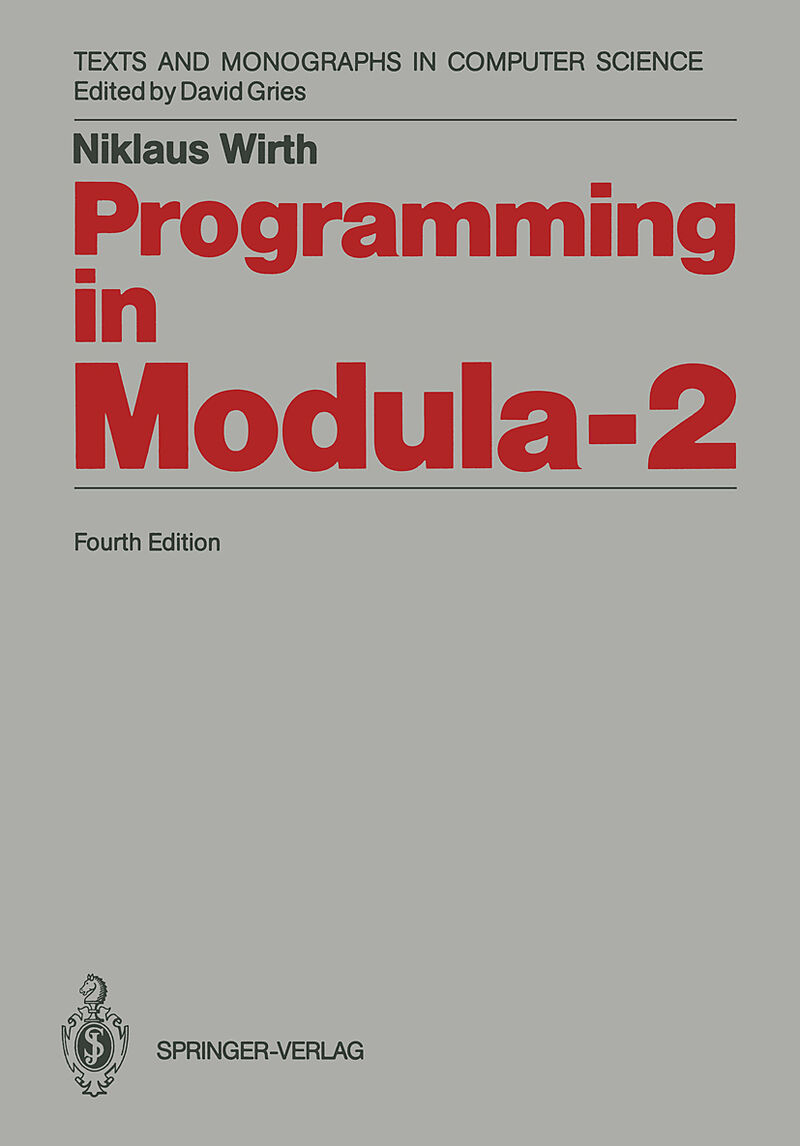Programming in Modula-2
Einband:
Kartonierter Einband
EAN:
9783642835674
Untertitel:
Monographs in Computer Science
Genre:
Programmiersprachen
Autor:
Niklaus Wirth
Herausgeber:
Springer Berlin Heidelberg
Auflage:
4th edition 1988. Softcover reprint of the origina
Anzahl Seiten:
192
Erscheinungsdatum:
08.12.2011
ISBN:
3642835678
This text is an introduction to programming in general, and a manual for programming with the language Modula-2 in particular. It is oriented primarily towards people who have already acquired some basic knowledge of programming and would like to deepen their understanding in a more structured way. Neveltheless, an introductory chapter is included for the benefit of the beginner, displaying in a concise form some of the fundamental concepts of computers and their programming. The text is therefore also suitable as a self-contained tutorial. The notation used is Modula-2, which lends itself well for a structured approach and leads the student to a working style that has generally become known under the title of structured programming. As a manual for programming in Modula-2, the text covers practically all facilities of that language. Part 1 covers the basic notions of the variable, expression, assignment, conditional and repetitive statement, and array data structure. Together with Palt 2 which introduces the important concept of the procedure or subroutine, it contains essentially the material commonly discussed in introductory programming courses. Part 3 concerns data types and structures and constitutes the essence of an advanced course on programming. Palt 4 introduces the notion of the module, a concept that is fundamental to the design of larger programmed systems and to programming as team work. The most commonly used utility programs for input and output are presented as examples of modules.
Klappentext
This is the 4th edition of a successful book which first appeared in 1982. It is an introduction to programming in general as well as a manual for programming with the language Modula-2 in particular. It is oriented primarily towards people who have already acquired some basic knowledge of programming and would like to deepen their understanding in a more structured way. Nevertheless, an introductory chapter is included for the benefit of the beginner, displaying in a concise form some of the fundamental concepts of computers and their programming. The text is therefore also suitable as a self-contained tutorial. The notation used is Modula-2, which lends itself well to a structured approach and leads the student to a working style that has generally become known under the title of structured programming. Modula-2 is a descendant of Pascal, and is particularly suited for programming larger and more complex systems in a structured way. The principal improvement in this 4th edition is a completely new layout. The main changes in the contents are a few minor adaptations in the area of type compatibility. "Programming in Modula-2" by Niklaus Wirth can be considered as the standard reference for Modula-2 programmers.
Inhalt
1 Introduction.- 2 A First Example.- 3 A Notation to Describe the Syntax of Modula.- 4 Representation of Modula Programs.- 5 Statements and Expressions.- 6 Control Structures.- 7 Elementary Data Types.- 8 Constant and Variable Declarations.- 9 The Data Structure Array.- 10 Procedures.- 11 The Concept of Locality.- 12 Parameters.- 13 Function Procedures.- 14 Recursion.- 15 Type Declarations.- 16 Enumeration Types.- 17 Subrange Types.- 18 Set Types.- 19 Record Types.- 20 Records with Variant Parts.- 21 Dynamic Structures and Pointers.- 22 Procedure Types.- 23 Modules.- 24 Definition and Implementation Parts.- 25 Program Decomposition into Modules.- 26 Local Modules.- 27 Sequential Input and Output.- 28 Screen-Oriented Input and Output.- 29 Low-Level Facilities.- 30 Concurrent Processes and Coroutines.- 31 Device Handling, Concurrency, and Interrupts.- Report on the Programming Language Modula-2.- Appendix 1: The Syntax of Modula-2.- Appendix 2: Standard Utility Modules.- Appendix 3: The ASCII Character Set.- Appendix 4: Syntax Diagrams.

Leider konnten wir für diesen Artikel keine Preise ermitteln ...
billigbuch.ch sucht jetzt für Sie die besten Angebote ...
Die aktuellen Verkaufspreise von 6 Onlineshops werden in Realtime abgefragt.
Sie können das gewünschte Produkt anschliessend direkt beim Anbieter Ihrer Wahl bestellen.
Loading...
Die aktuellen Verkaufspreise von 6 Onlineshops werden in Realtime abgefragt.
Sie können das gewünschte Produkt anschliessend direkt beim Anbieter Ihrer Wahl bestellen.
| # | Onlineshop | Preis CHF | Versand CHF | Total CHF | ||
|---|---|---|---|---|---|---|
| 1 | Seller | 0.00 | 0.00 | 0.00 |
